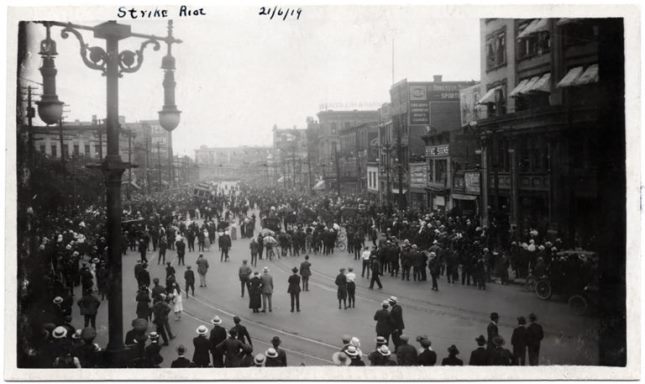Manitoba Building Trades Constructs a Safe, Sustainable Centennial
“Virtually every human endeavor starts with a construction project,” says Sudhir Sandhu, chief executive officer of the Manitoba Building Trades (MBT). “We emphasize that contribution.”
Sandhu has been building his career in unions, municipal government and private business for more than two decades. His unusual path to the top position in MBT, combined with a passion for team building and sustainable organizations makes him an ideal leader for MBT at this moment in time.

The Manitoba Building Trades (MBT) was founded on March 9, 1909, but it wasn’t until the events surrounding the Winnipeg General Strike in 1919 that the need for a centralized organization that could help individual workers gain the fair working conditions they sought became clear. MBT, known as the Winnipeg Building Trades Council at the time, provided that leadership. One hundred years later, it represents 13 unions and more than 8,000 construction and trades professionals working on billions of dollars’ worth of construction projects in Manitoba.
On the anniversary of the strike, the association took control of a seventy thousand square foot facility in the heart of Winnipeg that will serve as its headquarters as well as a hub for construction technology and safety training.
Sandhu spoke with Association Adviser about the challenges and evolution of the construction industry and how technology will change what and how workers contribute to this vital industry. He explains how MBT plans to invest in its members’ safety and professional success through new labour supply models, and how MBT plans to grow to meet the needs of Canadian workers for the next 100 years.
Association Adviser: Manitoba Building Trades is celebrating its 100th year in 2019. Congratulations! Tell us about its beginnings.
Sudhir Sundhu: As with many union organizations, the origin of Manitoba Building Trades is rooted in economic and social conflicts between workers and employers during the industrial era. At the outset, Winnipeg’s Building Trades and Metal Trades Councils did not have a formal structure as the right to collective bargaining was not supported by law. Individual trades created them to consolidate their economic strength by coming together under umbrella organizations.
The events of 1919 served as a catalyst to further drive the need for solidarity as the power of collective action became clearer. It became evident to workers and their craft-based unions that shifting the economic balance towards a better equilibrium required a strong central organization that could represent their mutual interests. Over the decades, the Metal Trades and Building Trades Councils have merged into a single organization.

AA: The 1919 Winnipeg General Strike is central to MBT’s founding and membership growth. Do you think it’s important that today’s members know this piece of history?
SS: We acknowledge that history is important. But its influence wanes over time as successive generations are further and further removed from having any personal connection to historical events. As these events fall further back in time, we tend to forget them. And that leads to the axiom that those who fail to recall the mistakes of history, are doomed to repeat them.
For today’s building trades professionals, the lesson is that civil and legal rights are not permanently gained. Once gained, they need to be protected against erosion and retrenchment. Reasonable wages, benefits, working hours, safe working conditions and the right to collective bargaining can all be traced back to 1919.
In our times, all these rights are under intense pressure as the legislative framework that protects these rights is increasingly under threat.
If present day members forget the story of their predecessors, they may well have to repeat their efforts to regain diminishing rights. Remembering must remain an active endeavour for all our members so they won’t have to repeat history.
AA: What has MBT done over the last century to ensure strong membership numbers, and an active membership?
SS: We have become much better in some respects but also have ground to gain on some fronts. The essential function of building trades unions is to act as human resource partners to their construction contractor business partners. The umbrella Building Trades organization represents these unions on strategic issues such as business development, legislative and regulatory policy and government relations. While individual unions and MBT have invested heavily in training and workforce development to maintain a productivity and safety advantage, our business model has been more conducive to the industrial-commercial-institutional (ICI) sector which has much larger scale projects.
This sector has benefitted from higher labour productivity and the ability of unions to mobilize a larger workforce for single projects. This however has not been supportive of more cost sensitive projects in smaller scale commercial and residential construction sectors.
As suppliers of highly skilled labour, this business model has left our members susceptible to employment/unemployment cycles in our dominant sector as ICI infrastructure investments can vary significantly over time.
We are now working hard to add new labour supply models that can be more responsive to additional sectors of the industry. We are also making substantial investments in incorporating technology to enhance productivity and safety. We will translate these investments into more sustained employment for our members.
AA: What is the value of trade membership, and trade professions in general, when there is a huge focus on college education and technology/data-based professions in modern society?
SS: For decades, we have devalued the craft and workmanship of construction and skilled trades professionals. Unlike many European states that treat craftspeople as artisans, North America has views skilled trades as secondary occupations for those who did not choose the university/college stream.
That self-created stigma has been consequential. We have denied meaningful opportunities for people who have a strong interest and aptitude for the skilled trades and lowered the number of people choosing these occupations or delayed entry to a later age for many. Ironically, that has benefitted those who did enter the trades because wages have been driven up by perpetual shortages of skilled labour.
The skilled construction trades offer well-paying and rewarding career options. We are finally starting to address these systemic issues by encouraging diversity and inclusion in the trades and by also breaking down the stigma around the skilled trades. As the stigma fades and more technology is adopted in construction, we expect the trades to become more attractive to more students at an earlier age.
AA: How do you help new staff members understand MBT’s culture?
SS: First, we focus on the significance of the value added by our members. Very literally, virtually every human endeavour starts with a construction project. From education to government to the arts and sciences, we need structures that will enable every human pursuit. We emphasize that contribution.
We also establish codes of conduct and performance standards that reflects the professionalism required to deliver the quality of services expected by our clients. Our training programs include modules dealing with the business of construction and how to maintain the right culture and attitudes from one project to the next even when constantly dealing with different employers and project environments.
AA: What current MBT projects or initiatives are you most excited about, and why?
SS: Exactly one hundred years to the day MBT members went on strike on May 1, 1919, our organization took possession of a 70,000 square foot facility in the core area of Winnipeg. A $12 million investment will transform this facility into our new corporate headquarters and a state-of-the-art training facility. We intend to lead the country in adopting new technology to train workers and also train them to use new technologies in construction. In doing so, we will maintain our competitive advantage by supplying the safest and most productive labour in the industry.

AA: What plans are in the works to ensure MBT is still active for another 100 years?
SS: Our new training facility is the next step in become a more agile and responsive learning-based organization. We know construction will change dramatically as technology replaces humans but also changes how humans participate in and add value to the construction industry. A sustainable future will depend on how well we adapt to these changes.
Remaining viable for another century will depend on our ability to see around the bend and being prepared for what is yet to become obvious. Our members count on us to prepare them for the future. We will use all resources available to us to support them for a sustainable and productive future.
https://www.facebook.com/ManitobaBuildingTrades/videos/398728573836809/?t=10
AA: Tell us about the professional path you took to the chief executive officer role at MBT.
SS: My career has been very diverse by choice. I was a business owner for almost a decade. I have held senior positions in government for nearly fifteen years and have held senior positions in two union organizations including MBT. Change has been a common theme to virtually everything I have done. Helping organizations make significant changes has always been a strong draw. I have welcomed the challenge.
MBT was no different. I do not come from the trades and as has been the case with most employment I have held, the discussion started with a call from a recruitment firm. It took nearly six months of discussions for us to reach the conclusion that we would be a good fit. The role at MBT was going to be a significant change undertaking. So far, my past experiences have served me well in delivering the change sought by MBT. I am very optimistic that we will be better prepared for future changes by becoming more agile and adapt to what the future will demands of us.
AA: What are you doing to ensure you continue to grow as a leader?
SS: If leading is part of my responsibility to my organization and our people, then it is dependent on four things; reading, writing, listening and learning from smarter people.
I read a lot but not as much as I want to. Time is always a barrier. For the past two years, I have started writing opinion pieces and feature articles on specific issues. For me, writing is an extension of reading. It helps you understand and grow by learning from others but by also organizing my own thoughts and learning to write coherently and meaningfully.
I work very hard to listen to my colleagues. We hire people for specific expertise and skill sets. We do not bring them on board to tell them what I know. We hire them to take on a specific responsibility of adding their knowledge to the mix so we are collectively smarter. Listening to my colleagues and talking through issues has most often yielded better outcomes.
Lastly, and most importantly, I try very hard to not let my leadership position close me off to the recognition that the world is full of far smarter people than I am. As cliché as that may sound, that recognition keeps me receptive to and inquisitive about what others know. That is a great source of new learning and gaining a broader perspective in life.
AA: In terms of your job, what keeps you up at night?
SS: We have people at work somewhere in our Province literally twenty-fours hours daily. They work in a dangerous industry with heavy equipment and multiple risks that must be carefully managed. Their safety is always my overwhelming concern. Wherever I may be across the world, my phone is always on day and night. And I hope it never rings in the night because something has gone wrong at the one of our project sites. Nothing else keeps me awake as we are well prepared to deal with whatever may come.

